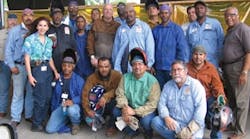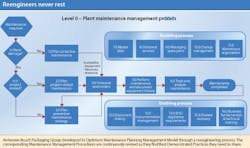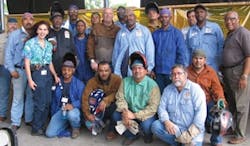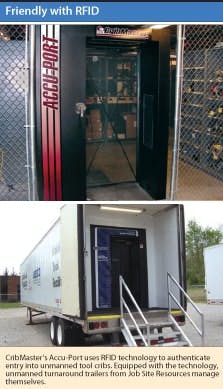Leading maintenance organizations are taking bold steps to improve workforce effectiveness and are constantly evaluating opportunities for further efficiencies. The challenge is to select the approaches that make sense in your environment and that will enhance the bottom line. Even then, a technology or process that works today might be inadequate tomorrow, making it essential to remain open to new techniques that are constantly emerging.
Here are 10 work-management strategies that represent the diversity of approaches being put into practice today. Some concepts are seasoned and others are new, but one thing is certain: They benefit not only the organization, but the workers themselves. Clarifying work, deploying cool technology, upgrading skill sets and offering more challenging roles are good ways to inspire greater enthusiasm among the workforce.
| 1. Evaluate your strategy |
| 2. Assess skills |
| 3. Develop knowledge |
| 4. Outsource appropriately |
| 5. Plan and schedule |
| 6. Go mobile |
| 7. Be more proactive |
| 8. Automate materials management |
| 9. Get clever |
| 10. Reward results |
1. Evaluate your strategy
One trend that has lasting value is to reassess your maintenance strategy periodically. Top performers won’t get too comfortable with the way they do business because inertia can set in. Fueling this trend is the fact that more executives are waking up to how reliability affects the bottom line, says Ricky Smith, senior reliability adviser at Allied Reliability (www.alliedreliability.com). “Improving reliability reduces maintenance and replacement costs, and this message is increasingly being pushed from the top down.”
John Yolton, maintenance strategy consultant for SKF Reliability Systems (www.skf.com), agrees. “Companies are finally realizing they need to run maintenance as a business to satisfy business goals.” Whether your preference is reliability-centered maintenance (RCM), total productive maintenance (TPM), operator-driven reliability (ODR) or another approach, a maintenance strategy review will determine what is or is not working for your equipment in your location.
As a means of maximizing equipment reliability, Yolton believes preventive maintenance (PM) is steadily losing favor, because the PM tasks are traditionally time-based. “Condition monitoring is the true means to predict maintenance and prevent failures,” he says. “For one, it is easier to rely on machine-generated reliability data than inconsistent work-order data.”
Benchmarking brings to light specific maintenance strategy weaknesses by showing how you stack up against the best and worst industry performers. Anheuser-Busch Packaging Group (www.anheuser-busch.com) has two benchmarking processes underway. The first, explains President and CEO Michael Harding, is external, where personnel participate in industry and vendor conferences to learn how other companies are managing the business of maintenance. “They continuously bring back ideas from these sessions that we weave into our maintenance management procedures.” The second involves internal benchmarking and audits at each plant to measure performance against goals. “This process has enabled us to find and share best demonstrated practices more efficiently.”
Periodically assessing your maintenance management software usage also is fundamental to this strategy. According to Smith, the more that companies spend on maintenance software, the less return they might see on their investment. “The problem is that usage rates aren’t rising. Many users aren’t putting the data in the system correctly - or at all.” Anheuser-Busch Packaging Group proactively enforces use of its SAP maintenance management system. “Follow-up audits make sure it’s consistently being used the same and right away at each plant,” Harding says.
2. Assess skills
Companies are increasingly seeking quid pro quo when making a job offers or instituting pay increases, says Tom Ramsay, president of Ramsay Corp. (www.ramsaycorp.com). “Employers want to pay for knowledge, not years of experience.” The more knowledgeable workers will be the more efficient performers.
Ramsay Corp. develops tests that measure production and maintenance labor forces. Benchmarks based on local and national normative data illustrate how the mechanics and electricians compare to others. Prepackaged or customized, the tests serve multiple purposes, including pre-employment screening, skills evaluation, promotional exams, pre- and post-training assessments, and certification testing.
“Some customers ask us to custom-design selection procedures for them. Bombardier Transport (www.bombardier.com) has us testing for master electrical and mechanical technicians,” Ramsay says. The tests cover not only technical skills, but training, supervision and leadership capabilities. “There is a lot of competition for the few who have these capabilities.”
Many companies are filling their skills gap with targeted training programs, building a competitive edge with formidable in-house capabilities. This welding class attended by water and wastewater maintenance personnel at the City of Houston was one of several progressive seminars performed on-site to mitigate retirement of seasoned personnel.
3. Develop knowledge
Many companies look outside for training to remediate skills gaps. National Technology Transfer (www.nttinc.com), an industrial technical training provider, delivers packaged and customized seminars that employ both lecture and hands-on strategies. In an effort to head off the effects of the pending retirement of an aging workforce, the City of Houston's Public Works and Engineering Department, Public Utility Division (www.publicworks.houstontx.gov) turned to NTT to retrain its water and wastewater maintenance staff. The training included best practices and procedures using new technology to increase productivity while improving skill sets for the next line of supervisors.
“The training took place at our site, under our current functioning conditions and using our equipment," says Senior Trainer Gloria Guerra. “Like any organization, resistance to change is a factor. With the tenacity of our training section and NTT’s qualified instructor, not only did a change in mind-set occur, but a high amount of learning took place.”
By alternating from a classroom setting to the field, the participants could quickly apply knowledge as it was gained. The training allowed participants to troubleshoot real-time problems from the field; reproduce the issue, learn correct methods and rationale in the classroom — a safe environment — and take the experience back to the field for application.
"It was unbelievable to witness," Guerra says. “Some supervisors started making changes even before the program was completed." An internal final exam indicated that knowledge parity was achieved between the younger and more seasoned personnel.
4. Outsource appropriately
Another task increasingly outsourced is maintenance. Don Johnson, vice president of marketing at Advanced Technology Services (www.advancedtech.com), says interest in outsourced factory maintenance and industrial parts and repairs has been growing despite the flagging economy. In an ATS-commissioned Nielsen Research study this year, 100 U.S. senior manufacturing executives were asked if they would outsource maintenance to bolster their plant operations against recession, and 63% of the respondents said yes.
“Companies are examining what is core within their organizations,” Johnson says. “Their business goal is to make products, not maintenance mechanics, and lacking sufficient maintenance competency can be costly.” Production downtime, according to the survey, costs the manufacturers an average of $21,200 per minute. Poor quality due solely to calibration errors this year will cost the organizations an average of $1,734,000. In contrast, when E-Z-Go Textron (www.ezgo.com) outsourced production maintenance to ATS, they realized 97% PM compliance, significant reductions in downtime, increased output and more than $570,000 in Six Sigma savings.
“With energy costs going up, demand is rising for energy audits on compressed air and motor systems,” says John Kronenwetter, director of national accounts for component distributor Kaman Industrial Technologies (www.kamandirect.com). “Additionally, plants concerned about sustainability and green manufacturing practices can as much as double the lives of their lubricants with the aid of our fluid analysis and on-site filtering services creating savings on waste disposal, man hours and material costs.”
Many plants can reduce costs by taking advantage of services that manage warranties and repairs of motors, drives, circuit boards — even gearboxes. “We work with a number of our customer partners to track OEM warranties, capture service information and where it makes sense, we’ll negotiate extended warranties for them,” Kronenwetter adds.
Contractor organizations can offer an alternate career path. ATS is experiencing 20% annual growth and plans to add 700 employees within the next 18 months.
5. Plan and schedule
Too many organizations don’t. When Idcon (www.idcon.com) asked companies worldwide why planners don’t plan, about 1,000 responses were tallied. The leading reason was they lacked close cooperation between operations and maintenance. Second, the planners weren’t given enough time to plan. Third, the companies lacked good technical databases.
Christer Idhammar, president of Idcon, recommends developing a partnership organization to address the O&M gap. “Maintenance doesn’t sell a service — it sells equipment efficiency through service. Operations and maintenance need to work as partners to properly prioritize tasks.” To solve the time factor, he says a good PM system can reduce reactive maintenance and breakdowns. As for the technical database, “It’s easier to keep this information up if it’s captured early, during the design and engineering stage.”
Idhammer recommends using your best craftspeople as planners, provided they like to plan and are organized. “It’s a step up for most craftspeople, and it’s where we’ve seen the best success. We also suggest involving crafts in estimating job schedules, because they tend to find this task interesting and challenging.”
Schedule efficiencies are being realized with lean shutdown management. “To be lean, you need to ask which tasks are really necessary during shutdown,” Idhammar says. “If jobs can be moved to a weekly or daily schedule, and if some PMs conducted during shutdown can be converted to condition-based maintenance, then the amount of work and time spent during shutdowns will be reduced.”
With better planning and scheduling, fewer staff and contractors will be required and less overtime will be paid. Some employees will be lost through attrition. The rest can be moved to more analytical work, such as looking at past problems, analyzing why they occurred and developing solutions.
6. Go mobile
By now, companies without mobile technology already know they should have it, and those with a wireless infrastructure in place are working to make their maintenance processes more efficient. According to Rich Padula, president and CEO of Syclo (www.syclo.com), “This is because mobile computing is an easy concept to grasp. Eliminating paper and redundant processes with mobile technology allows you to move data at much less cost, make your personnel more productive, and gather more data about the equipment.” Standardizing data capture and processes also helps companies make the transitions that come with an aging workforce.
Increasingly, productivity gains from reducing paperwork are being exceeded by productivity gains of the assets themselves thanks to improved data, Padula says. For example, when a machine initiates a work order that is dispatched automatically to a technician’s wireless device, it ensures data capture, speeds repair and reduces the risk of downtime.
The mobile experience is being enhanced continually. Voice technology is reducing the number of clicks required. Syclo has a speech-enabled multimodal logistics system that combines speech recognition and text-to-speech capabilities with peripherals such as bar code scanners, RFID, wireless printers, digital cameras, GPS and GIS.
Imaging technology makes processes easier to perform and the results are more consistent. You can click on an equipment schematic to expand specific parts and show intended readings or record the actual readings. You can select a picture that best resembles a physical condition rather than drop-down descriptions that are subject to interpretation. And, you can store digital photos with the work history to avoid typing lengthy descriptions of equipment condition.
Mobile computing also is being used to automate big project tasks, like refinery turnarounds. Integrating mobile devices with project management software replaces the paper trail and the project is completed quicker, in the correct sequence, and with greater safety and accountability.
7. Be more proactive
Reducing unplanned downtime allows the maintenance workforce to concentrate on more preventive and predictive activities. One cause of unplanned downtime is short circuits and overloads that cause open-circuit events. A study by Cooper Bussmann (www.cooperbussmann.com) found that open-circuit events result in an average of 41 minutes of downtime and cost from $300,000 to millions of dollars in downtime per manufacturing site per hour.
According to Joe Fox, director of systems and services, “The Cooper InVision downtime reduction system automatically alerts maintenance workers within 90 seconds of an open-circuit event, with instructions on where the incident occurred, what parts are needed and what personal protective equipment (PPE) to bring. The result is a faster time to respond and reduced time to repair.” One component manufacturer experienced about 36 open circuits per year. With InVision, the drop in mean-time-to-repair resulted in potential savings of $11,875 per event, and ROI was realized in one month.
8. Automate materials management
Robert Holmes, marketing director for WinWare (www.cribmaster.com) says, it can take 30 minutes at large facility to get a tool or supplies, between shutting down the machine, traveling to the crib, waiting for the item, returning to the equipment and starting it up. The advent of RFID changed all that. Now companies can place high-use items at the point of use in a secured environment, and allow automated checkouts and returns.
"When you walk through CribMaster’s Accu-Port portal system, your RFID badge is authenticated automatically. As you walk out, the system automatically tracks the materials you take," Holmes explains. "All management decisions (e.g. when to order, move or calibrate) occur electronically." Supplementing the primary tool crib with point-of-use RFID technology can shrink its physical size and the amount of inventory it contains. In addition, automating reorders reduces the cost to cut purchase orders.
“Materials management can improve workforce efficiency — or disrupt it,” Kronenwetter says. “To maximize efficiency, make electronic connections to suppliers where possible. Integrate the vendor into the workflow so parts and materials orders are generated automatically. Also, ask to receive parts pre-kitted for PMs.”
Crown Equipment (www.crown.com) chose Accu-Port to provide its employees 24-hour, unmanned access to tools and supplies. They tagged reusable packaging rather than the products to save on tags and simplify restocking. Labor costs were reduced because a 24-hour position was replaced with a 90-minute, light-duty restocking role. Walk time and downtime were reduced, productivity improved and better purchasing information led to an $83,583 reduction in annual inventory usage.
Job Site Resources is leveraging CribMaster technology in its turnaround trailers. With proper authentication, contractors can rent tools from within an unmanned truck trailer. The system provides accountability for the materials and controls returns to reduce lost tool costs. Additionally, it shows maintenance personnel which tools were used so that unnecessary refurbishments can be avoided.
9. Get clever
Plant Services constantly describes new tools and innovative ways of getting the job done, and technologies that you might have seen as too expensive keep moving into the affordable range. For example, inspections can be risky endeavors, but an increasing number of these tasks can be performed by remote control. Aerial video inspections are safer and less expensive with Draganfly Innovations’ (www.rctoys.com) SAVS, a miniature radio-controlled electric helicopter with a wireless color video camera. Rather than renting a full-sized plane or helicopter, the self-leveling and anti-vibration camera system can capture and transmit live video to a ground base station.
Mikron Infrared (www.mikroninfrared.com) supports remote-controlled infrared inspections of electrical cabinets. The electrical panels don’t need be opened or removed, and infrared-transparent windows (or sight glass) aren’t necessary. Closed-door inspections using Mikron’s SpyGlass help to avoid unscheduled downtime, damaged equipment and accidental injury. The savings quickly add up. A gas-enrichment plant that once experienced $1 million in lost production traced to an electrical connection problem was able to detect a similar problem with the SpyGlass and prevent a reoccurrence.
10. Reward results
Nucor Corp. (www.nucor.com) has used production bonuses as workforce incentives as far back as the 1970s. Donovan Marks, manager of compensation and benefits, says there are four types of compensation for plant floor personnel — base pay, production bonus, profit sharing and 401(k) match.
“Our base pay is low, but an average of 80% to 170% of the base wage is paid in bonus. The bonus is measured by quality tons out the door,” Marks says. Because production bonuses can be significantly higher than the base salary, employees work hard to keep production running. Better preventive maintenance prevents downtime. When equipment fails and production stops, maintenance and production work as a team to get it running as quickly as possible.
The bonus rate is adjusted when new technologies or skills lead to more quality tons produced. “Once they start reaching 200% or 225% production bonus, we’ll take them back to scale. Our employees understand this is necessary because we need to remain competitive in the steel industry and hold costs down,” Marks explains.
Profit sharing is calculated as a percentage of the base plus bonus, and the payout is 10% of total corporate earnings before income tax. “Fiscal year 2007 was our second-best year for profitability, which reflects positively on our incentive-based compensation.”
Today’s work-management trends help the bottom line and, at the same time, empower the workers. While the company realizes business benefits, the employees experience greater satisfaction from working with modern technology systems, developing new skills, performing more analytical tasks, and earning higher wages based on proven skills and performance. Even modest investments can have a maximum impact. In a slow economy, improving business viability and the individual’s marketability are invaluable strategies to follow.
--------------------------------------------------------------------------------
Related content
Enterprise Asset Managment/Computerized Maintenance Management System Resource Center
http://www.plantservices.com/resource_centers/management/EAM_CMMS.html
SAP Knowledge Center
http://www.plantservices.com/knowledge_centers/sap/index.html



